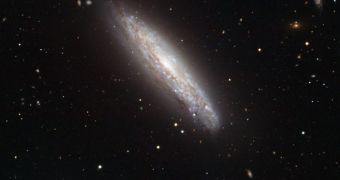A team of investigators using a Chile-based telescope managed to capture a very peculiar image of a distant galaxy, which evidenced signs of an unusual “superwind” of flowing gas.
According to the science team, this superwind was in fact cause by gas being expelled from the galaxy at very high speeds, which creates an impressive visual effect.
The new image was collected using the MPG/ESO 2.2-meter telescope at the La Silla Observatory in Chile, which is operated by the European Southern Observatory (ESO).
The Wide Field Imager instrument was used to look at the galaxy called NGC 4666, which is clear in this image as well, in center stage.
One of the 4 things that immediately sets NGC 4666 apart from other galaxies is the fact that it has a very large of new stars forming within. Its stellar nurseries are still extremely active.
This means that they churn up new, blue stars at a fast pace, a process that may contribute to the superwinds the ESO crew identified.
The new observations of the galaxy were conducted after the flows were originally analyzed by the XMM-Newton telescope, which is operated by the European Space Agency (ESA).
“The prominent galaxy NGC 4666 in the center of the picture is a starburst galaxy, about 80 million light-years from Earth, in which particularly intense star formation is taking place,” says a press release on the ESO website.
“The starburst is thought to be caused by gravitational interactions between NGC 4666 and its neighboring galaxies, including NGC 4668, visible to the lower left. These interactions often spark vigorous star-formation in the galaxies involved,” the document reads further.
According to the image snapped by the WFI in visible wavelengths, it would appear that the superwind originates within the bright central region of NGC 4666, and that the feature extends for tens of thousands of light-years into the surrounding space.
“The [WFI] observations were made in visible light to further investigate these serendipitously detected X-ray objects – a good example of how astronomers using different telescopes work together to explore the Universe,” the ESO team concludes.
The organization keeps numerous telescopes in Chile, due to the fact that the Atacama Desert is the driest place in the world, without any discernible precipitations.

 14 DAY TRIAL //
14 DAY TRIAL //